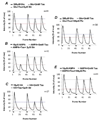Reciprocal regulation between taurine and glutamate response via Ca2+-dependent pathways in retinal third-order neurons
- PMID: 20804625
- PMCID: PMC2994392
- DOI: 10.1186/1423-0127-17-S1-S5
Reciprocal regulation between taurine and glutamate response via Ca2+-dependent pathways in retinal third-order neurons
Abstract
Although taurine and glutamate are the most abundant amino acids conducting neural signals in the central nervous system, the communication between these two neurotransmitters is largely unknown. This study explores the interaction of taurine and glutamate in the retinal third-order neurons. Using specific antibodies, both taurine and taurine transporters were localized in photoreceptors and Off-bipolar cells, glutamatergic neurons in retinas. It is possible that Off-bipolar cells release juxtaposed glutamate and taurine to activate the third-order neurons in retina. The interaction of taurine and glutamate was studied in acutely dissociated third-order neurons in whole-cell patch-clamp recording and Ca2+ imaging. We find that taurine effectively reduces glutamate-induced Ca2+ influx via ionotropic glutamate receptors and voltage-dependent Ca2+ channels in the neurons, and the effect of taurine was selectively inhibited by strychnine and picrotoxin, but not GABA receptor antagonists, although GABA receptors are present in the neurons. A CaMKII inhibitor partially reversed the effect of taurine, suggesting that a Ca2+/calmodulin-dependent pathway is involved in taurine regulation. On the other hand, a rapid influx of Ca2+ through ionotropic glutamate receptors could inhibit the amplitude and kinetics of taurine-elicited currents in the third-order neurons, which could be controlled with intracellular application of BAPTA a fast Ca2+ chelator. This study indicates that taurine is a potential neuromodulator in glutamate transmission. The reciprocal inhibition between taurine and glutamate in the postsynaptic neurons contributes to computation of visual signals in the retinal neurons.
Figures








Similar articles
-
Intracellular calcium release resulting from mGluR1 receptor activation modulates GABAA currents in wide-field retinal amacrine cells: a study with caffeine.Eur J Neurosci. 2003 Jun;17(11):2237-48. doi: 10.1046/j.1460-9568.2003.02652.x. Eur J Neurosci. 2003. PMID: 12814357
-
Membrane currents evoked by ionotropic glutamate receptor agonists in rod bipolar cells in the rat retinal slice preparation.J Neurophysiol. 1996 Jul;76(1):401-22. doi: 10.1152/jn.1996.76.1.401. J Neurophysiol. 1996. PMID: 8836233
-
Glutamate modulation of GABA transport in retinal horizontal cells of the skate.J Physiol. 2003 Feb 1;546(Pt 3):717-31. doi: 10.1113/jphysiol.2002.034421. J Physiol. 2003. PMID: 12562999 Free PMC article.
-
Role of taurine in the central nervous system.J Biomed Sci. 2010 Aug 24;17 Suppl 1(Suppl 1):S1. doi: 10.1186/1423-0127-17-S1-S1. J Biomed Sci. 2010. PMID: 20804583 Free PMC article. Review.
-
The highly integrated dialogue between neurons and astrocytes in brain function.Sci Prog. 1999;82 ( Pt 3)(3):251-70. doi: 10.1177/003685049908200304. Sci Prog. 1999. PMID: 10534972 Free PMC article. Review.
Cited by
-
Taurine: A Source and Application for the Relief of Visual Fatigue.Nutrients. 2023 Apr 12;15(8):1843. doi: 10.3390/nu15081843. Nutrients. 2023. PMID: 37111062 Free PMC article.
-
Taurine activates delayed rectifier Kv channels via a metabotropic pathway in retinal neurons.J Physiol. 2013 Jan 1;591(1):123-32. doi: 10.1113/jphysiol.2012.243147. Epub 2012 Oct 8. J Physiol. 2013. PMID: 23045337 Free PMC article.
-
Taurine deficiency damages retinal neurones: cone photoreceptors and retinal ganglion cells.Amino Acids. 2012 Nov;43(5):1979-93. doi: 10.1007/s00726-012-1273-3. Epub 2012 Apr 4. Amino Acids. 2012. PMID: 22476345 Free PMC article.
-
Taurine as a potential therapeutic agent interacting with multiple signaling pathways implicated in autism spectrum disorder (ASD): An in-silico analysis.IBRO Neurosci Rep. 2023 Sep 2;15:170-177. doi: 10.1016/j.ibneur.2023.08.2191. eCollection 2023 Dec. IBRO Neurosci Rep. 2023. PMID: 37711998 Free PMC article.
-
Rational Basis for Nutraceuticals in the Treatment of Glaucoma.Curr Neuropharmacol. 2018;16(7):1004-1017. doi: 10.2174/1570159X15666171109124520. Curr Neuropharmacol. 2018. PMID: 29119928 Free PMC article. Review.
References
-
- Sturman JA. Taurine in development. J Nutr. 1988;118:1169–1176. - PubMed
Publication types
MeSH terms
Substances
Grants and funding
LinkOut - more resources
Full Text Sources
Other Literature Sources
Miscellaneous

